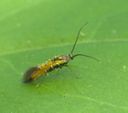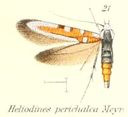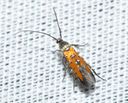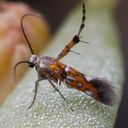Sun Moths
Heliodinidae
Classification
- Phylum: Arthropoda
- Subphylum: Hexapoda
- Class: Insecta
- Order: Lepidoptera
- Superfamily: Yponomeutoidea
- Family: Heliodinidae
Pronunciation
How to pronounce Heliodinidae: /ˌhiːlioʊˈdaɪnɪdiː/
These audio files are automatically generated. While they are not always 100% accurate, they are a good starting point.
Images






Summary
Heliodinidae, or sun moths, are a family of metallic-colored, diurnal moths with a wide distribution and specific larval feeding habits on plants primarily in the Order Caryophyllales.
Physical Characteristics
Members of the family Heliodinidae are metallic-colored, have slender bodies, narrow wings, and exhibit significant dorsal and lateral setae on the pupa.
Identification Tips
Look for metallic-colored scaling on the body and wings, compact head scales, and the unique posture of raising hind legs at rest, though not all genera display this feature.
Habitat
Found in most parts of the world, often associated with their larval host plants.
Distribution
Mostly in the New World, with described species spread globally.
Diet
Larval host plants mainly from families in the Order Caryophyllales, such as Aizoaceae, Chenopodiaceae, Phytolaccaceae, Portulacaceae, and Nyctaginaceae; some feed on Onagraceae, Araliaceae, and Piperaceae.
Life Cycle
Moths are mostly diurnal, with a pupal stage characterized by long stiff hairs on the dorsum.
Ecosystem Role
Pollinators, playing a role in ecosystems involving their larval host plants.
Collecting Methods
- Light trapping
- Netting during daytime
- Observation of larval host plants
Preservation Methods
- Pinned specimens
- Dried and mounted
- Stored in entomological collections
Similar Taxa
Misconceptions
The raising of hind legs at rest is not a defining characteristic, as some genera do not exhibit this behavior.
Tags
- Heliodinidae
- Sun Moths
- Diurnal Moths
- Lepidoptera
- Ecology